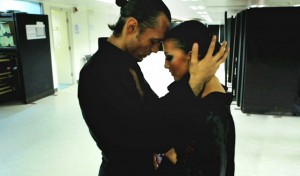TRIBECA REVIEW: ‘Ballroom Dancer’

Ballroom Dancer, an intimate portrait of dance partners Slavik Kryklyvyy and Anna Melnikova, looks closely at two people and how they grow closer and further apart both professionally and personally. Although rough around the edges (the subtitles are still off and not all of the footage feels necessary), the documentary proves to be an effective look at the craft of ballroom dancing and the many hours it takes to realize perfection. The 84-minute film is part of New York City’s Tribeca Film Festival.
First-time filmmakers Christian Bonke and Andreas Koefoed have complete access to Slavik and Anna. They are present at rehearsals, competitions and hotel rooms. The camera is never turned off, so the audience is able to watch them prepare for the international contests in all aspects. They support each other, and also tear each other down. Their relationship is sometimes hostile, with Slavik pouring on the criticism of his younger partner, but there’s a real sense of love (and loss) between the two.
As their relationship unspools, it becomes clear that the two dancers are on completely different tracks. Anna is young and fairly new to the scrutiny of competition. Slavik, on the other hand, dazzled audiences in his youth when he partnered with Joanna Leunis in the late 1990s and early 2000s. Since that heyday, he has taken a backseat in the world of dancing, all the while watching Joanna succeed and win championship after championship with her new partner. In many ways, it appears that Slavik uses Anna to retain those glory days, to bask in the spotlight one more time. (One unfortunate missing link: There’s no interview with Joanna).
The power and agility that comes with dance preparation is on fine display in the documentary. The two performers put in hours of rehearsal, so much so that their joints and muscles take a beating. When Anna misses a move, Slavik shows his disappointment. Throughout the film, he comes to realize that she’s not quite the same as Joanna. But the conundrum is twofold: They’re partners both on the dance floor and off. He truly loves her and also needs her for the competition. This constant give-and-take makes Ballroom Dancer a fascinating document of people yearning for the final prize.
When the subtitles are improved, the film should play very well on the indie market throughout the United States. Competition documentaries, like Spellbound, Jig and Under the Boardwalk, always seem to do well, especially when they tap into the audience’s inherent competitive nature. Slavik and Anna speak both Russian and English, almost interchangeably. The filmmakers have decided to include subtitles for the majority of the film, which is helpful, but distracting. When the titles don’t match the English words spoken on screen, it’s hard to follow along.
Ballroom Dancer succeeds on many levels, and that’s largely due to its intimacy. Nothing seems out of bounds or off limits. There’s never a scene when Slavik or Anna turn to the camera and ask for some privacy. They let us in, always inviting us to see their triumphs and pain.
By John Soltes / Publisher / John@HollywoodSoapbox.com



